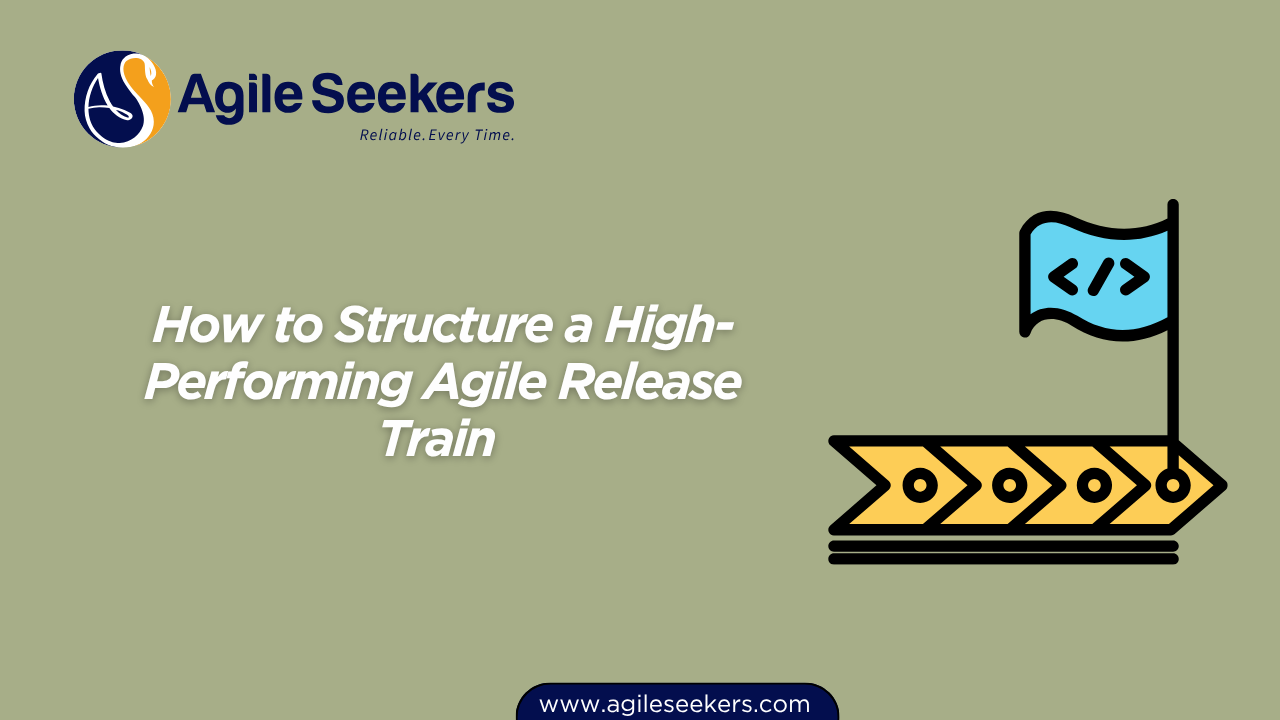How to Structure a High-Performing Agile Release Train

A high-performing Agile Release Train (ART) doesn’t happen by accident. It requires deliberate design, consistent leadership, empowered teams, and alignment across value streams. If structured correctly, an ART delivers value continuously, reduces handoffs, and builds a culture of relentless improvement.
Let’s break down the key structural elements and best practices needed to launch and sustain a high-performing ART.
1. Define the Value Stream First
Before forming an ART, clearly define the value stream it will serve. This means identifying how value flows from concept to delivery across the business. Avoid aligning ARTs to functions (like “dev team” or “QA group”)—instead, align them to customer-facing capabilities.
Use the Value Stream Identification Workshop to map out operational and development value streams. The ART should be organized around a development value stream that has a clear purpose and measurable outcomes.
A well-structured ART typically consists of 50–125 people from cross-functional teams working together to deliver on a shared mission.
2. Build Cross-Functional Agile Teams
Each ART includes multiple Agile Teams, and every team should be cross-functional and self-organizing. That means they include all the roles necessary to define, build, test, and deliver increments of value.
To ensure these teams are structured for success:
-
Include developers, testers, UX, DevOps, and sometimes even legal or compliance.
-
Teams use common Agile practices (Scrum, Kanban, or SAFe Team Kanban).
-
Every team has a dedicated Scrum Master and Product Owner.
You can explore the foundational training for these roles through the SAFe Scrum Master Certification and SAFe Product Owner/Product Manager Certification programs.
3. Establish Key ART Roles and Responsibilities
High-performing ARTs depend on clear roles and accountabilities. These include:
-
Release Train Engineer (RTE): Facilitates ART events, supports PI Planning, removes systemic impediments. The SAFe Release Train Engineer Certification prepares RTEs for this critical leadership role.
-
Product Management: Owns the program backlog, sets priorities, and connects the ART with customer needs.
-
System Architect/Engineering: Provides architectural direction and enforces intentional architecture that supports the continuous flow of value.
-
Business Owners: Key stakeholders who own the value delivered by the ART and actively participate in PI Planning and system demos.
4. Use Program Increment (PI) Planning as the Anchor Cadence
PI Planning is the heartbeat of the ART. It’s a two-day, face-to-face (or remote) event that aligns all teams around a common set of objectives for the upcoming increment.
During PI Planning:
-
Teams break down features into user stories.
-
Risks are identified, ROAMed (Resolved, Owned, Accepted, Mitigated).
-
Dependencies are mapped and coordination is planned.
PI Planning aligns everyone on vision, priorities, and capacity. To run this event effectively, train facilitators using the Leading SAFe Certification program.
5. Ensure Continuous Integration and DevOps
Without DevOps and a working CI/CD pipeline, your ART will struggle to deliver consistently. High-performing ARTs embed DevOps practices into their structure:
-
Automate builds, tests, and deployments.
-
Build a culture of shared responsibility for quality.
-
Invest in infrastructure as code and trunk-based development.
SAFe’s CALMR approach—Culture, Automation, Lean flow, Measurement, Recovery—should guide your DevOps transformation. SAFe guidance on DevOps offers detailed strategies.
6. Establish Metrics That Reflect System-Level Performance
To continuously improve, ARTs need to measure what matters. Don’t limit yourself to team-level velocity. Instead, track:
-
Flow Metrics: Flow Time, Flow Efficiency, Flow Load.
-
Quality Metrics: Defect escape rate, automation coverage.
-
Outcome Metrics: Business value delivered vs. planned.
Regular Inspect & Adapt (I&A) events help ARTs reflect on results, run problem-solving workshops, and adjust practices.
7. Drive Leadership Engagement and Cultural Alignment
ARTs thrive when leaders are engaged—not just in status updates, but in enabling transformation. Agile leaders should:
-
Model Lean-Agile thinking.
-
Empower teams rather than command decisions.
-
Invest in coaching and upskilling.
Programs like the SAFe Advanced Scrum Master Certification help Scrum Masters move from team-level coaching to enterprise facilitation, influencing systemic improvement across ARTs.
8. Integrate with Lean Portfolio Management
Your ART cannot work in isolation. It should be connected to strategy through Lean Portfolio Management (LPM). That includes:
-
Participating in Portfolio Kanban.
-
Aligning features to strategic themes.
-
Operating under a Lean budget guardrail.
This alignment ensures the ART’s efforts are directly tied to business outcomes.
9. Nurture the ART as a Team of Teams
An ART is not just a collection of teams—it’s a team of teams. To strengthen this identity:
-
Celebrate ART-wide wins.
-
Share learning across teams.
-
Encourage joint problem-solving during Inspect & Adapt events.
Build social cohesion using Communities of Practice, shared innovation time, and system demos that involve the full ART.
10. Invest in Long-Term Learning and Coaching
Even high-performing ARTs require ongoing support. Agile Coaches and RTEs should:
-
Continuously mentor Scrum Masters and Product Owners.
-
Facilitate team-level and ART-level improvements.
-
Monitor system health and act on feedback loops.
Investing in Agile coaching capabilities, including Leading SAFe Agilist Certification Training, helps leaders build lasting agility.
Final Thoughts
Building a high-performing Agile Release Train requires far more than getting a few teams together under one umbrella. It’s about aligning around value, building empowered cross-functional teams, and continuously improving at scale. With the right roles, processes, and cultural mindset, your ART can deliver fast, sustainable, and measurable business outcomes.
To learn how to prepare your teams and leaders for ART success, explore programs like:
Also, you can find in-depth framework details on Scaled Agile’s official ART page.
Also Read - From RFP to Collaboration: How to Build Agile-Aligned Contracts
Also see - How System Demos Drive Alignment and Quality




















